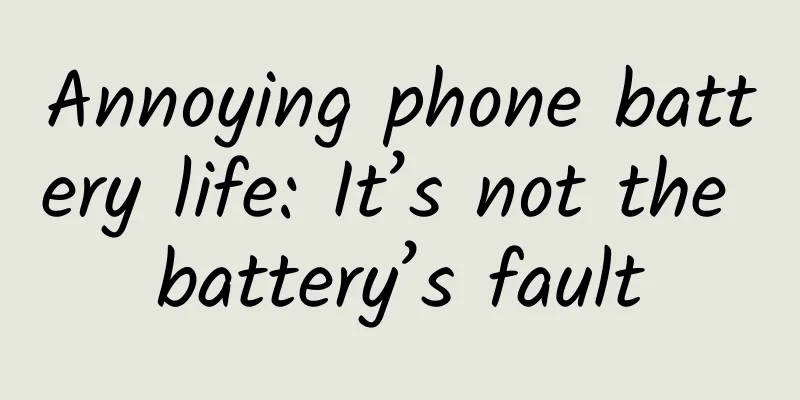Annoying phone battery life: It’s not the battery’s fault

|
The functions of the smartphones we use nowadays are becoming more and more powerful, but we find that the time we use them cannot keep up with the frequency of our use. We always find that the phone runs out of power at the critical moment. So, besides the battery power, what else does the battery life depend on? Capacity is not the only thing, capacity density ratio is also important Batteries are like mobile phone cameras. You can’t just look at the surface parameters. Apple’s 800W once beat many brands’ 1300W. The same is true for batteries. You can’t just look at the capacity, but also the capacity density. Currently, the capacity density ratio of mobile phone batteries is mostly around 350Wh/L. Even if the battery is made larger, the volume is still a lingering problem. Therefore, if you want to increase the battery life while maintaining lightness and thinness, the capacity density ratio is very important. For example, analyst @孙昌旭 once said on Weibo that the battery used in Xiaomi Mi 4 has the highest energy density at present, reaching 620-630MH/L, while the battery energy density of general mobile phone manufacturers is around 560-580WH/L. However, the advantage of Xiaomi Mi 4 will not last long. According to Sun Changxu, by next year, high-energy-density batteries with a density of 700WH/L based on silicon negative electrode materials will be commercially available, and several domestic flagship mobile phones are currently testing them. Charge and discharge cycle times Heavy mobile phone users are well aware of this. After a certain number of charge and discharge, the total power of a mobile phone battery will decrease to varying degrees. iPhone users may have a deeper understanding of this. The current national standard is that 80% of the power should remain after 400 charge and discharge, which means that after about a year, the battery will only have 80% of its original power when fully charged. Unfortunately, before there is a breakthrough in battery technology, all electronic digital products will remain in this state, such as laptops, digital cameras, etc. Hardware Adaptation If you want to get a longer battery life, then the choice of hardware for your phone will inevitably involve trade-offs. For example, if the screen can be 720p, don't use 1080p; if it can be 1080p, don't use 2K; if it can be AMOLED, don't use IPS. If the SOC can use 4 cores, it will never use 8 cores. If the A53 core can be used, it will never use the A57 core, etc. These are also crucial to improving battery life. Higher configurations often mean more power consumption. Of course, if some devices use more advanced processes, power consumption can be reduced. Software optimization When it comes to software optimization, we tend to think of manufacturers' system optimization. For example, the Android system has become smoother and more power-efficient since its inception, thanks to many improvements, such as the process of background tasks and the alignment of task wake-up times. In addition, it also involves hardware algorithms, such as the collaborative calling algorithm between SoC multi-cores, etc. Of course, this requires cooperation between hardware manufacturers and software developers to achieve the best results. These are all software-side optimizations of battery life. Fast charging technology Although charging is not counted in the battery life, it can indirectly improve the battery life experience. And if your battery is too full, fast charging technology is a way to make up for the shortcoming of longer charging time. Not only have chip manufacturers such as Qualcomm and MediaTek come up with their own fast-charging solutions, but some mobile phone manufacturers have also developed fast-charging technologies with independent intellectual property rights, such as OPPO's VOOC flash charging technology. Once you use it, you can never go back. I give OPPO a thumbs up. In addition, many manufacturers are also developing their own fast-charging technologies or using fast-charging technologies from other manufacturers. In the future, mobile phones may be equipped with fast-charging technologies. The above are several indirect ways to improve the battery life of mobile phones. Before there is a major innovation in batteries, this can only be regarded as a compromise. In fact, manufacturers hope to bring better mobile phone performance to consumers. Of course, this must take the battery life of the mobile phone into consideration. We also look forward to a qualitative breakthrough in battery life in the near future. As a winner of Toutiao's Qingyun Plan and Baijiahao's Bai+ Plan, the 2019 Baidu Digital Author of the Year, the Baijiahao's Most Popular Author in the Technology Field, the 2019 Sogou Technology and Culture Author, and the 2021 Baijiahao Quarterly Influential Creator, he has won many awards, including the 2013 Sohu Best Industry Media Person, the 2015 China New Media Entrepreneurship Competition Beijing Third Place, the 2015 Guangmang Experience Award, the 2015 China New Media Entrepreneurship Competition Finals Third Place, and the 2018 Baidu Dynamic Annual Powerful Celebrity. |
<<: Classic fighting game comes to the big screen TV version "Exile Blade" closed beta experience
>>: These excellent apps will only appear on the Android platform
Recommend
The entire province of Hubei recognizes health codes from other provinces, and no one may request additional certificates!
China News Service, March 19. According to the we...
Money issue? Should I buy a genuine Win10 USB drive for 745 yuan?
Using a USB flash drive to install the system has...
App Store "localization" high-end technology will take you to fly!
In order to better serve different countries and ...
Basic knowledge of POS machines, understand POS machine knowledge
The POS machine used always jumps code, which caus...
Your immune system is attacking your own people? It turns out you have this incurable disease
- Introduction - During a physical examination at...
I have written 4,000 articles in 5 years. Here are my 17 tips for new media startups!
If a startup wants consumers to pay attention to ...
What? The coffee you love so much was discovered by sheep first!
Review expert: Peng Guoqiu, deputy chief physicia...
A large area of coal mines in Inner Mongolia collapsed, and rescue was difficult! A picture to understand open-pit coal mines and safety production
Produced by: Science Central Kitchen Produced by:...
Is it more economical to refuel in the morning? Check out the common misconceptions about refueling in life
Is it more economical to refuel in the morning th...
Best recommendation for Chengdu 90-minute unlimited studio, worth collecting
Reservation arrangements for 90-minute unlimited ...
How many mobile phone manufacturers have lost in Nokia’s patent war?
The patent war between Apple and Samsung lasted f...
Family members, this kind of food may really cause cancer, I really advise you to eat less
Pickled beans, pickled cucumbers, crispy radishes...
Why not choose one year of training instead of four years of university?
[[142050]] I am a college student. I am currently...
Baiguoyuan’s private domain growth strategy!
Today’s case is a complete breakdown of Baiguoyua...
“Hahaha”, this is the reason?!
Source: Minitory This article has been authorized...









